GENESIS LIFEFORMS
We created an NFT collection to launch Anitya and build its community
CHALLENGE
- Design a unique 3D generative NFT collection with multiple utilities and community rewards
- Acknowledge the contributions of initial community supporters and convey the essence of the brand via a creative digital art initiativePROCESS
- Assembled a team with experts in crypto, nuclear physics, algorithmic art, web design, and Solidity, with Franco Palioff as our chosen artist Franco Palioff
- The project focused on crafting artistically valuable NFTs that capture the project's spirit and utilize digital potential
- Imagined multiple tiered utilities for using AnityaRESULTS- 11,500 unique generative art NFTs that illustrate Anitya's theme of fleeting existence, with each piece reflecting a unique system component
- The launch strategy prioritized building a strong community, creating shared benefits, and securing funding for Anitya's future

GENESIS NFTs are about:COMMUNITY:
- an instrument to explore different types of community engagement between owners / wannabe owners
- a way for collectors to express themselvesBRAND:
- statement of vision
- standards in artistic exploration
- using web3 and NFT tech
experimentation
- algorithmic / metadata
- gamification
- utility and so on
- longevityHYPE:
- Collectability / desirability
- Speculation
- PR / Marketing
- Trading volumeCROWDFUND:
- Capital raise
- Seed & launchpad
- Trading fees

We developed an engaging and quirky website with Webflow, aiming to resonate with the rebellious spirit of the crypto and gaming communities. The site features lifeforms that track the user's cursor movement
Here is the LIFEFORMS website
Some important Product requirements from our kickoff meeting
- Extract 7-9 traits for rarity indicators.
- Utilize token ID numbers for identification.
- Generate a histogram from 3D algorithmic data, including color, palettes, geometry, and characteristics like 'pinchy', spiky, number of arms, etc.
- Task Zach to translate this into 2D for NFT metadata purposes.
- Validate outputs with 'FMP' software.
- Allow manual curation of traits and assignment of certain rarities.
- Aim to construct a detailed and flexible trait matrix to support a variety of combinations and future generative minting opportunities.
- Enhance the ways to link utilities within the Anitya metaverse and its related products.
- Franco is responsible for creating an easy-to-understand trait map

NFT Release Strategy and Metaverse Integration Summary
Our NFT project innovated with a unique release strategy that intertwines whitelisting (WL) opportunities with each NFT drop. The approach is such that owning an NFT from an initial release can automatically grant access to a WL spot for an equivalent number of NFTs in subsequent releases. For instance, if our first release comprises 10,000 NFTs and the second release has 1,000, then up to 1,000 WL spots for the second release could be allocated to owners from the first, ensuring a 10% WL opportunity.Easter eggs and rarity levels within these NFTs will influence who gets WL access, with the aim of creating a balanced system where the NFT holdings from earlier releases can grant access to later ones. For example, a holder of NFTs from the second release (1,000 NFTs) could have a shot at half the WL spots for the third release (500 NFTs).The NFTs also serve as a passport to a variety of metaverse experiences, including:- Custom avatars with quality and effects based on NFT rarity.
- VIP access to the Anitya metaverse, featuring exclusive areas.
- Future WL spots for upcoming Anitya NFT drops.
- Access to a special VIP Discord channel for foundational members, such as the 'Nirvanas'Following are a few example lifeforms

The NFT project will have multiple auction releases, with a points system rewarding collectors leading to a potential free final drop. Devoted collectors can collaborate on custom avatars and metaverse creations to become creators in the ecosystem. The project also explored ideas like a community-driven metaverse self-fund where NFTs grant governance tokens, and metadata customizationIn the metaverse, NFT traits will unlock special effects. A new land NFT lease/purchase system is being developed to ensure a sustainable in-world economy.
Overall, the goal was to create an expansive metaverse experience deeply integrated with a sophisticated NFT release structure

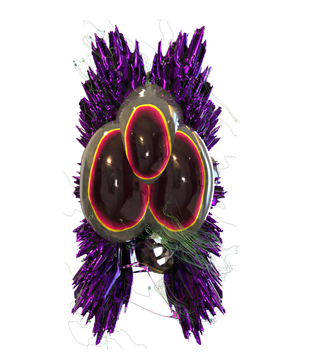
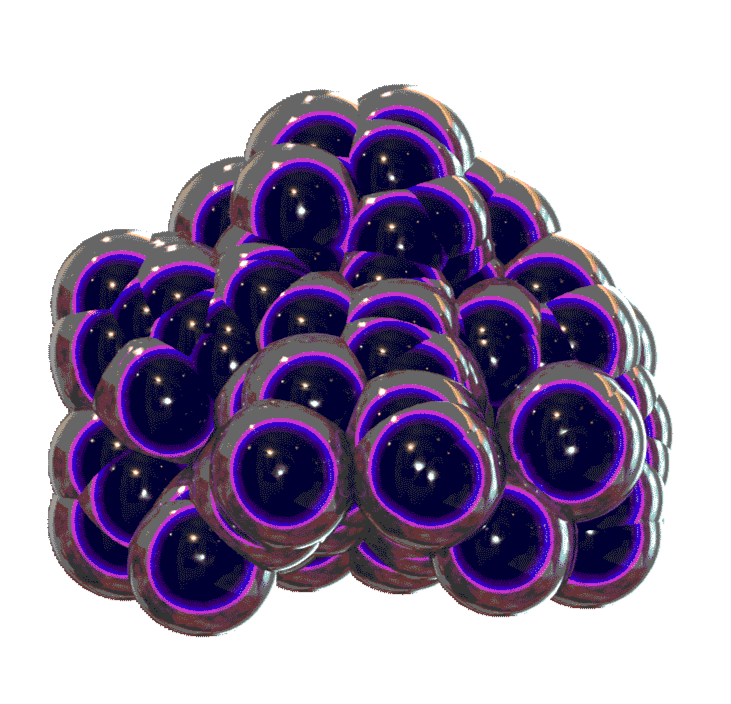
TECHDRIFTS
Providing tech insights as a Service
Go To Techdrifts Website
FOUNDING THESIS
- New topics in tech should be quick to learn
- Hedge fund research should be available for everybody
CHALLENGE
Keeping up with fast-changing technology is hard when many new trends appear at the same time. I want to make these new developments easier to understand by writing clear, well-researched reports on specific topics that founders, entrepreneurs, solopreneurs, freelancers, consultants, hustlers etc. can subscribe toPROCESS
I dedicate 50-100 hours to deep-dive into a niche topic, developing insights. These insights are then substantiated with numerous examples to build conviction for those insightsRESULTS
This project is in progress. Stay Tuned!!
Go To Techdrifts WebsiteTechdrifts is an Insights as a service. Here is an example screenshot of latest reports

To add value with distinctive viewpoints, I include Daily Macro Reports—a succinct synthesis of macroeconomic and market analysis. Understanding macro trends is crucial, as they are the gears that drive the global economy. My service aims to equip the target audience with the tools necessary to navigate these broad economic currents.

Strategy
The approach is to distribute free, condensed reports as a preview, with the aim of enticing readers to purchase the complete, detailed versions. Go to FREE REPORTS

INFRANODUS
Explored new uses for the tool and updated its outdated tech stack (8 years old) for better performance
CHALLENGE- Refine the UX/UI for better user engagement.
- Conduct thorough product discovery to unveil additional compelling use cases.
- Boost revenue streams and derive valuable insights.PROCESS
- Acknowledging the product's complexity and associated learning curve, I dedicated substantial effort to conducting 50-100 experimental graphs to ascertain the tool's capabilities and boundaries.
- Implemented a structured product discovery process, leading to actionable UX improvement recommendations.
- Used FREE NOW customer support data with the company's permission to uncover insightsRESULTS- Successfully doubled the subscriber base, escalating monthly revenue from €7,000 to €14,000.
- Identified and crafted multiple new use cases, broadening the product's applicability and market reach.
- The targeted emphasis on UX refinement significantly enhanced the product's usability and appeal.
- Gathered more insights specific to FREE NOW markets in Europe. Also Improved features like Feedback collection on FREE NOW app that is in use by millions

Background
Infranodus, the brainchild of the exceptionally intelligent researcher and developer Dmitry Paranyushkin (My client), was first envisioned crafted 8 years ago.Infranodus allows you to Generate Insights with AI and Knowledge Graphs. You can quickly get an overview of any discourse, reveal the blind spots, enhance your perspective.Over time, advancements in UX and technology have necessitated a comprehensive update. Dmitry enlisted my expertise to elevate his innovative tool.My Contribution
I dedicated several months to meticulously evaluate and enhance the user experience (UX) of Infranodus. By extensively testing and pinpointing areas for improvement, my focus was to ensure that the UX delighted its users
Have a look at the viral video of my client Dmitry (Founder of Infranodus) with 700k views on youtube


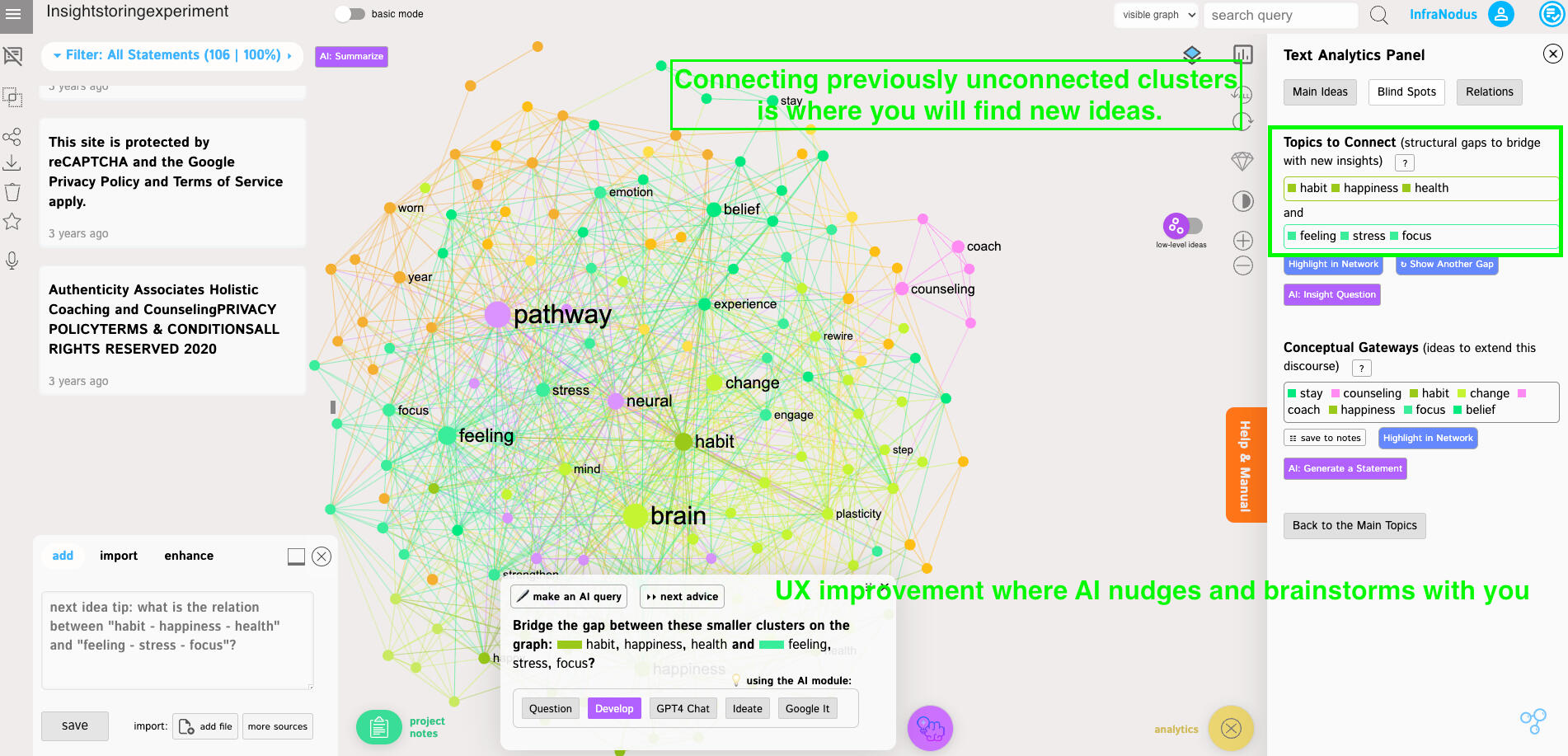
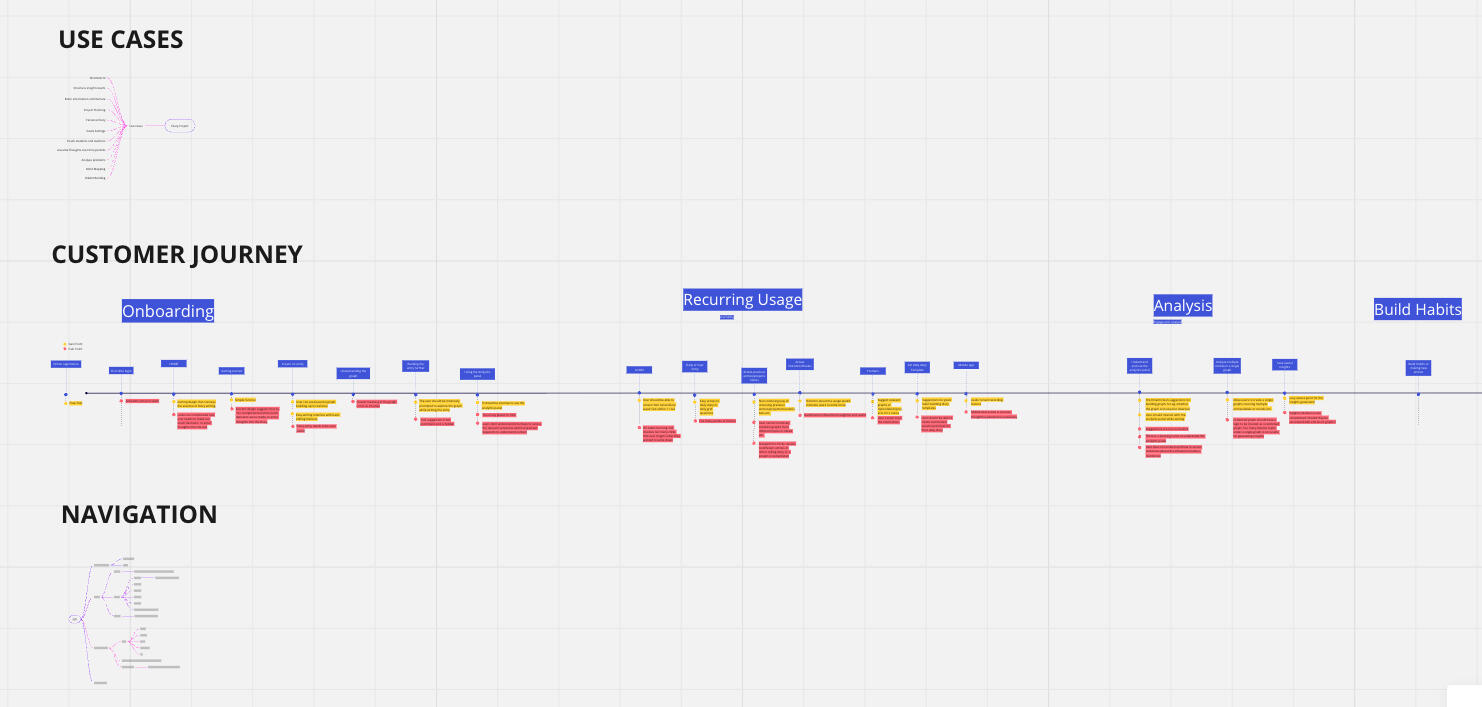
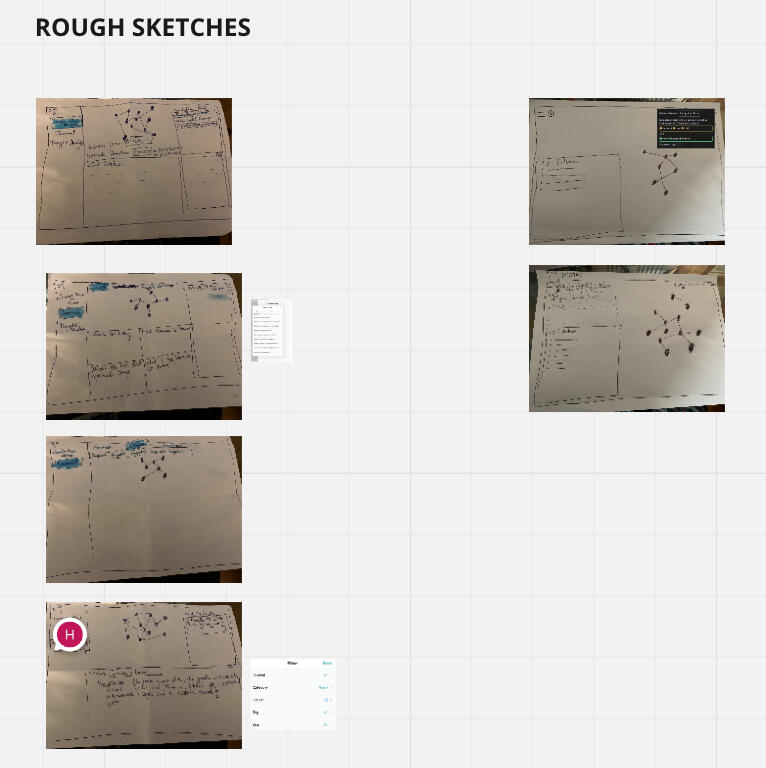
In my quest to push Infranodus to its full potential, I rigorously tested the tool, which, admittedly, led to it breaking on several occasions. This intensive process, however, bore fruit in the form of numerous new use cases. Below, I'll share a selection of these discoveries.Working closely with Dmitry, we have explored these possibilities in depth. As a result of this collaborative effort, some of these innovative use cases have now been seamlessly integrated into Infranodus, enriching the tool's functionality and user experience.
Use Case #1: Insightful Personal Diary
Enhanced Self-Reflection with Infranodus:Infranodus, with its advanced graphical analysis, has the potential to delve into and reveal profound personal insights. My vision involved simplifying the Infranodus experience by minimizing its broader features to focus on this particular niche use case. The goal was to design a streamlined user interface that leverages the powerful Infranodus backend, enabling users to deeply engage with their innermost thoughts and reflections.Diary competitor Analysis
- Monkkee
- Journey Cloud
- Penzu
- Mydiary
- DiarO Online
- WorkflowyNone of them offer a graph or insightsHave a look at the Diary Prototype yourself.



Use Case #2: Network analysis of a Twitter account Convinced Dmitry to connect Twitter API and analyze the data quickly with infranodus graphOne could use Twitter to quickly analyze the interest cluster of a social media account. The graph below is for Elon Musk. He clearly has 3 clusters of interests
1. Tesla
2. SpaceX
3. Trolling Twitter accounts and joking around

Use Case #3: Discovering Network Interactions SwiftlyEfficient Connection Mapping: Quickly ascertain which accounts are interacting with or connected to a target account with this specialized use case. This feature is designed to streamline the process, providing rapid insights into your network's dynamics

ANITYA
We build immersive multiplayer experiences without dev-time
FOUNDING THESIS
Metaverse building should be as easy as building websites
CHALLENGE
After working on 2 metaverse enterprise projects for big clients we uncovered many challenges- Lack of Flexibility: Proprietary technologies constrain the ability to adapt, making the development of integrations and bespoke experiences highly problematic.- Centralized Ownership: Control of assets remains in the hands of a few, with dominant platforms such as Unity, Unreal, and Roblox under the purview of large American and Chinese corporations.- High Entry Barriers: Demanding hardware specifications make these platforms less attainable in Global South, accompanied by formidable learning curves.- Unfair Value Distribution: Noteworthy projects are subjected to onerous revenue sharing arrangements, with Fortnite extracting 95%, Roblox claiming 75%, and Meta projecting a 50% take.- The creation of Metaverse and Games is not easy. It demands a diverse and extensive set of skills to successfully launch a product of merit. Our ambition was to democratize this process, to empower educators, students, and people from all walks of life to craft captivating 3D immersive environments.PROCESS- Our initial step involved a deep dive into the existing ecosystem, dominated by two major game engines, alongside a variety of lesser-known alternatives. We selected Godot as the foundation for our infrastructure.
- We gathered an exceptional multidisciplinary team comprising of game developers, software architects, game designers, product designers, product specialists, 3D artists, and environment designers.
- Employing product discovery and Agile methodologies, we expedited the development of our MVP and its subsequent deployment into production.
RESULTS- Successfully raised $2M in venture capital.
- Hired the founder of Godot — the foremost open-source game engine — as our Chief Technology Officer (CTO).
- Assembled and led a multifaceted team of professionals, including game developers, software architects, game designers, product designers, product specialists, 3D artists, and environment designers. At our peak, the team consisted of 20 highly skilled individuals

My fellow founders and I invested considerable effort in perfecting our branding. Ultimately, we settled on the name "Anitya," a Sanskrit term that translates to "impermanence." The name is emblematic of the ever-evolving nature of our immersive experiences, highlighting our commitment to continuous innovation and transformation in the world around us.Following collaborative projects with Tales of Us and the Goethe Institute, we gained a profound understanding of the most pressing issues within the industry. Motivated by these insights, we set out to address and overcome these challenges

After a lot of deliberation and research, we decided to build our infrastructure on Godot. The biggest Open source modular gaming engine


- Fastest growing developer community
- Open source/transparent
- Easiest to learn and developers love it
- Light and customizable
- Editable via Web
- Fully interoperable and modular
We conducted extensive research to map the competitive landscape and gain a clear understanding of the existing market offerings

We aspired to make Anitya the most flexible metaverse builder platform, with a high degree of interoperability and gamification

We concluded that Our differentiation was going to be built around these core pillars


Our objective was to reduce the hardware requirements, thereby making immersive experiences more accessible and enjoyable for a wider audience.
Together with my co-founders, we assembled an exceptionally diverse team, boasting a wide range of expertise. For instance, our team included 6 distinct types of designers, each very important part of the team. I led Product Development and Engineering aspects of our project

We did many Product discoveries and leveraged a lot of industry knowledge together with our team. Here is an example of Crazy 8 workshop to start designing our UI for the world builder

Next I defined user journey from the experience user perspective and started gaining conviction towards MVP and the User Flow

The User flow is fairly complicated and took us some time to lock onto


After multiple iterations and together with the engineering team, we devised a backlog and roughly broke down the MVP into 5 sprints. We constantly conducted grooming to keep up with the features that would go into the MVP


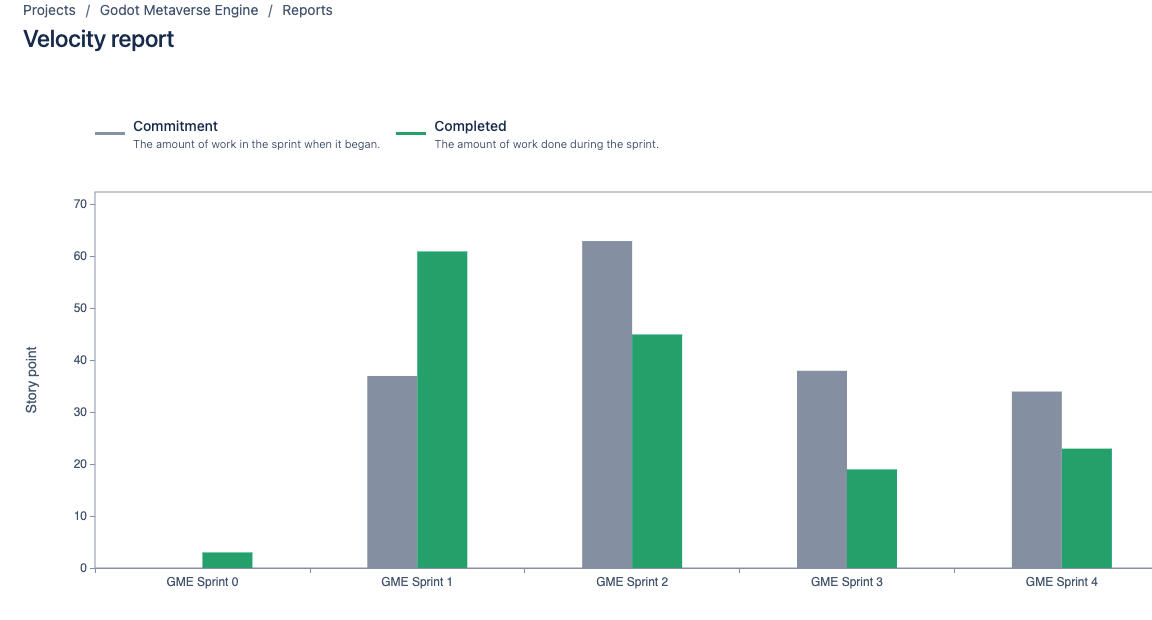

We brainstormed ideas for our first worlds

We ran 6 hats workshops for Retrospective and sometimes to make decisions on important features

We worked to ensure that we got the Control and the Character right


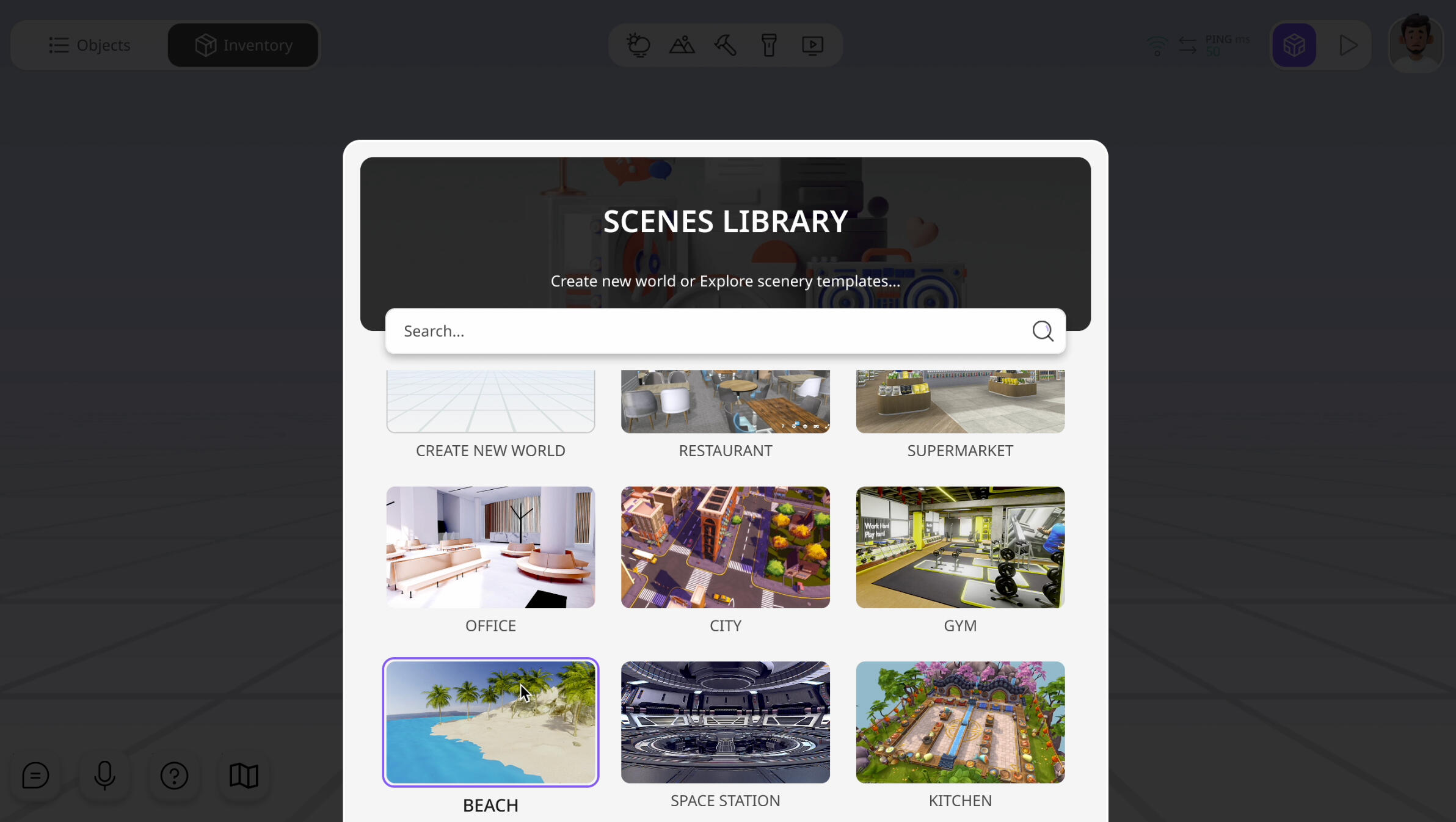
We often ran full team QA processes to uncover critical bugs and provide valuable feedbacks for the next sprint

We did a lot of Product Discovery around world builder. Since we had a couple of 3D designers building immersive spaces at the same time, we tried to make it easier for them to build.
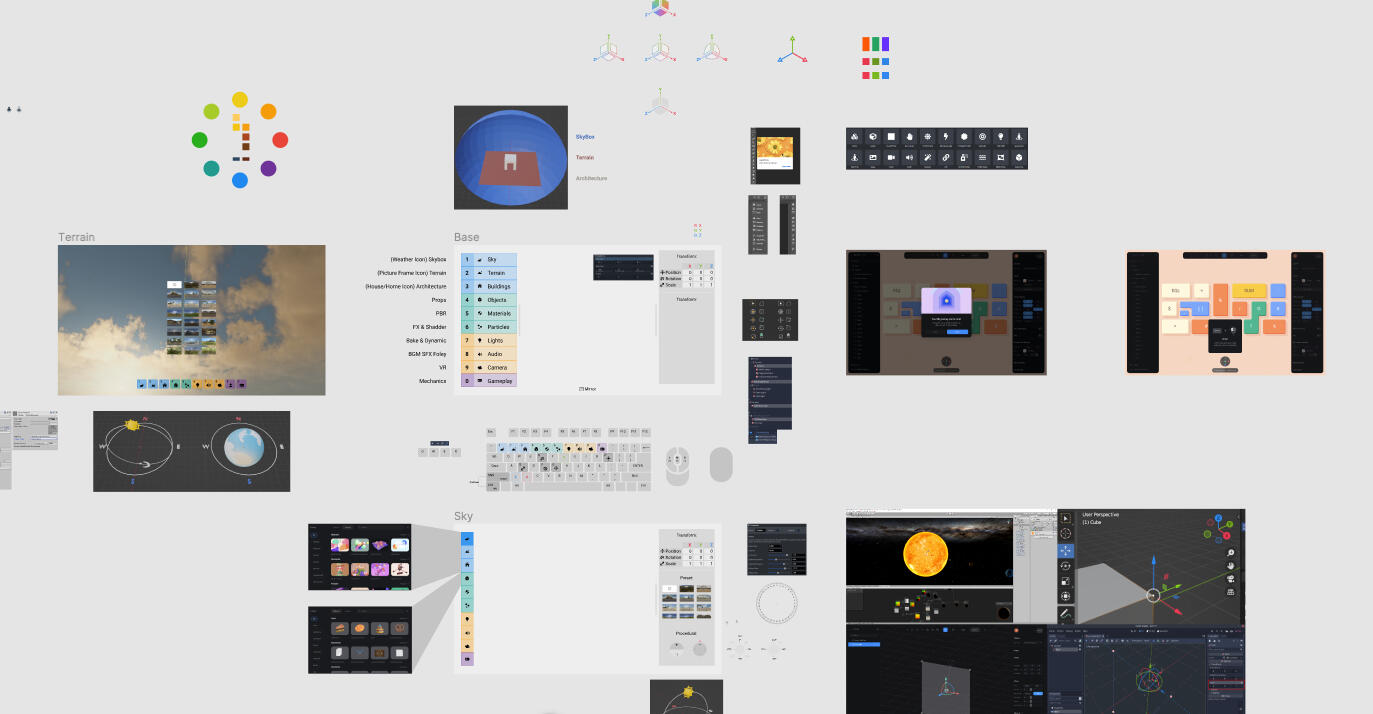
We settled on the top level important classification of features in the world builder

Our world builder, was internally used by our own 3D artists. This expedited feedback loops on the product

It was important that we conducted Product Discovery on many other important features and game mechanics. We explored primitives where multiplayer users could edit worlds with basic LEGO building blocks and construct interesting assets in runtime


We also conducted an experiment involving the integration of Web3 technology, which would allow users in possession of specific NFTs to access exclusive areas. However, this integration turned out to be more complex than anticipated. As a result, we had decided to temporarily suspend the development of this feature, primarily because the Godot engine has not yet reached a level of readiness for production deployment


Closing Thought: We had a lot of fun building the product

FREE NOW
Built and shipped features currently in use by millions. Cannot go into so much in detail since NDA's still in place
CHALLENGE
- Transform an outdated taxi app into a super multi modal app with Scooters, Mopeds, Cars, Public Transport, Car Rentals, and Taxis
- Implement a rapid, automated Driver License check enabling passengers to engage in car sharing within 3 minutesPROCESS- Conducted product discovery with multiple stakeholders to define the scope and requirements for multi modal features
- Ensured the technical specifications were in place to transition the app into a versatile platform that serves multiple mobility providers (Future proof B2B Backend Architecture)
- Introduced a Feedback feature in the app to collect valuable user insights, fostering continuous product improvementRESULTS- Successfully launched a Multi-Modal app now operational in over 170 cities across Europe, serving millions of users
- Influenced a significant market shift, leading to Uber exiting the shared mobility space in Europe and selling its JUMP bikes service.
- The enhanced backend architecture now robustly supports bookings from 15 B2B partners, catering to a variety of needs and user flows. This has transformed the old taxi app into a sleek, multi-modal mobility platform

BackgroundFree Now serves a user base of ± 50 million.
In 2019, following Daimler and FREE NOW's pivot away from autonomous vehicle ambitions, the company embarked on a strategic exploration into the future of mobility. This extensive research culminated in the decision for Free Now to aspire to become the 'Super App'
– a one-stop destination for all mobility needs.
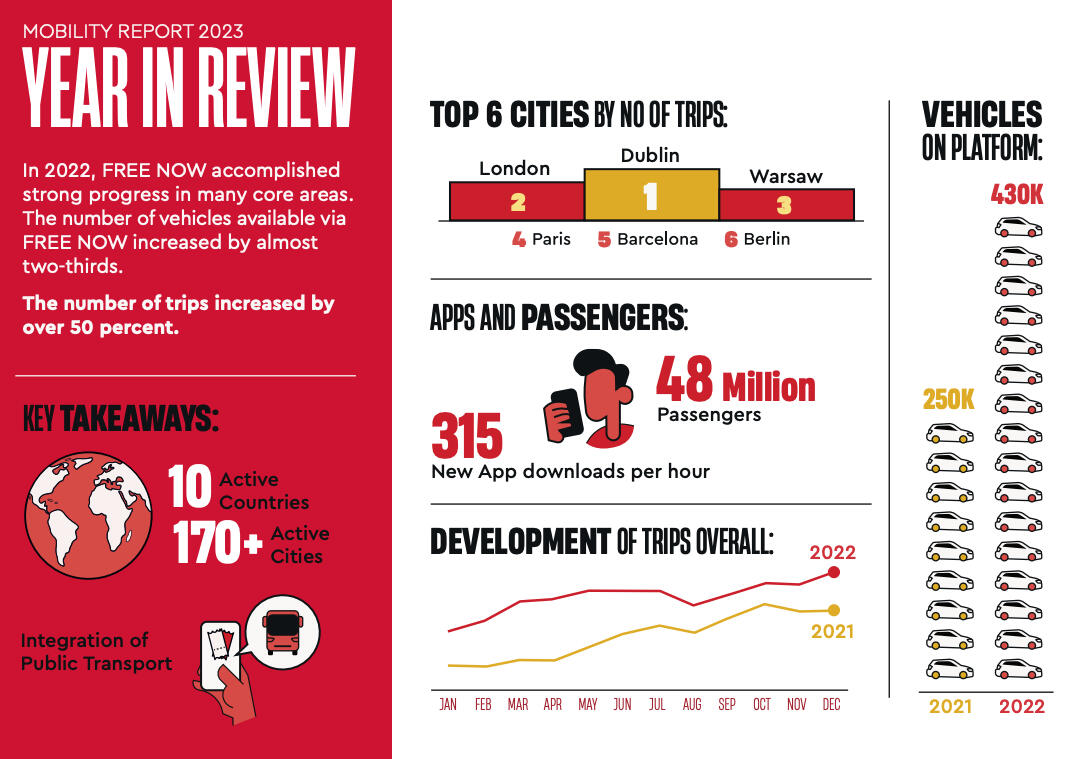
The legacy Taxi stack had grown increasingly complex over a decade of operations, accumulating a dense network of interlinked microservices.

The Berlin-based autonomous team was agile and seasoned, perfectly suited for piloting innovative experiments. Tasked with pioneering multi-modality solutions, our team was charged with creating a foundation for the platform capable of assimilating data from diverse partners and delivering it in a uniform format to our 50 million users

We quickly set out to explore the User journey and start planning our sprints. Despite our competitor Jelbi's three-year head start, we were resolved to deliver a service on par with theirs in record time. Below are several screenshots from our product discovery phase


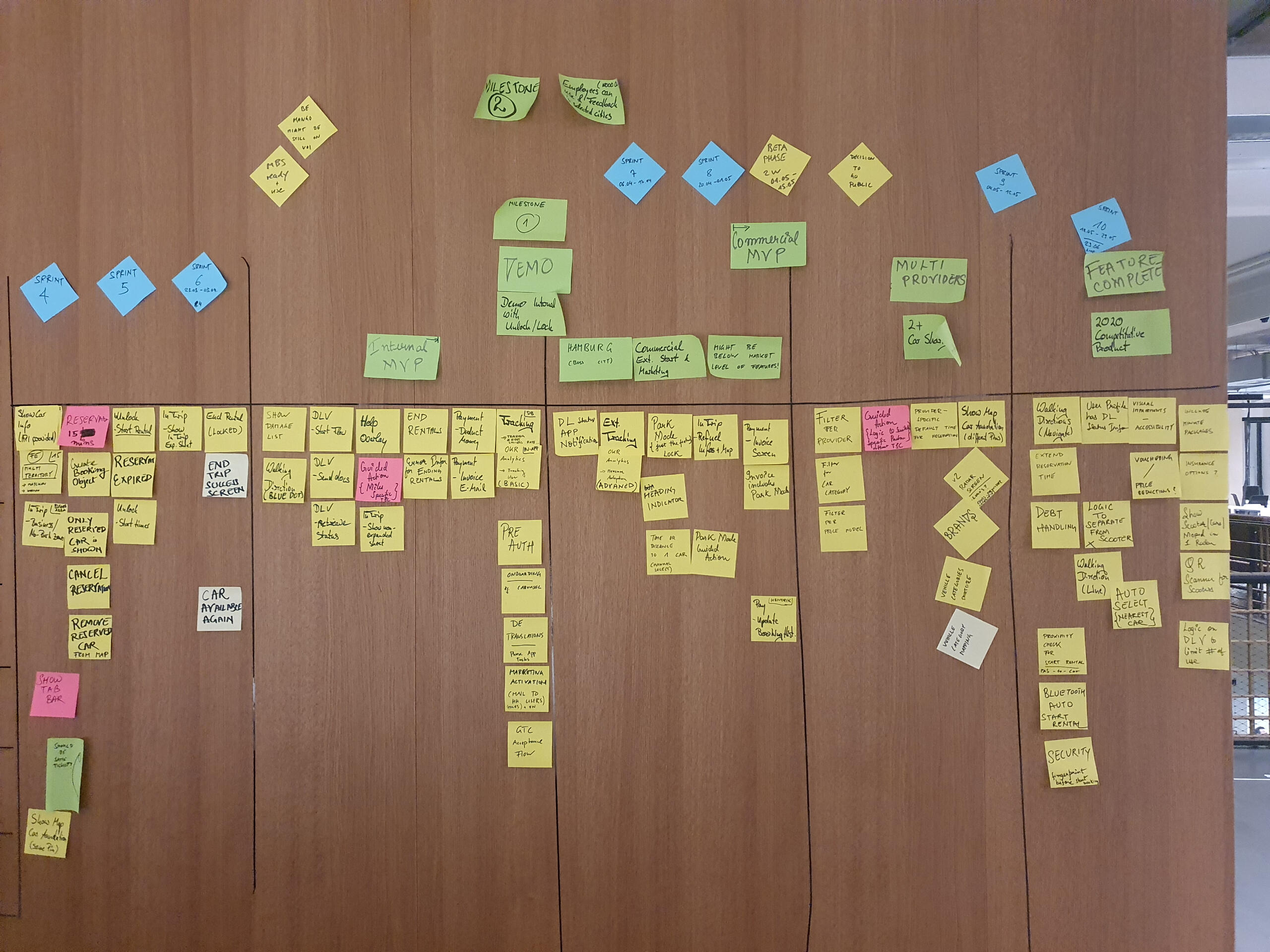
Miles and VOI were our inaugural partners, with Miles then being a burgeoning startup of just 15 employees. They executed many strategies effectively, including collaboratively developing their backend in tandem with our team. Now, they have expanded to over 350 employees.A few examples of integration challenges are as follows- Each partner operates within a distinct geographic area, which our app needed to accurately interpret and convey.
- The unique in-app assets of each partner required standardization to ensure they were correctly displayed within our platform.


RESULTSMulti Modality (NEXT Team) was clearly successfull and saw massive growth. Here are some numbers in the following figures

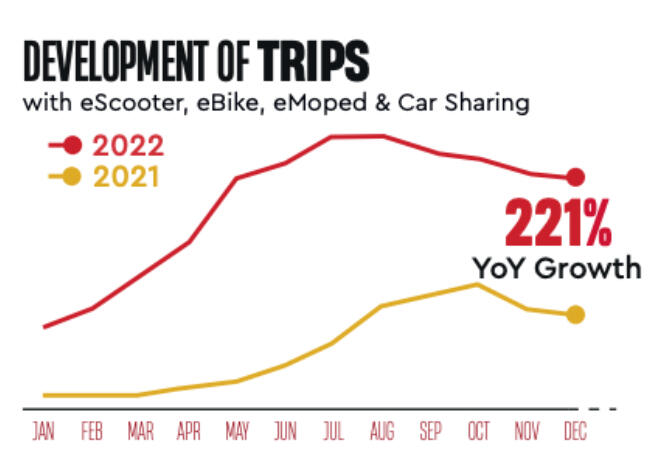

Currently it has over 15 Mobility partners serving them all from the Super APP FREE NOW
DAIMLER / FREE NOW
CHALLENGE
- Prepare systems and local operations to support autonomous ride-hailing following an iterative approach
- Produce well-defined, tested and ingestible ODDs, as well as maturing the Autonomous ready tech stack
- Test user journey and experience with end-to-end partner integration (Free Now)
PROCESS
- For the years to come, self-driving vehicles (SDV) will have restricted driving capabilities compared to a human. Understanding when to send a human driver vs. a SDV will be key- Identified the UX and User journey of the Hybrid Autonomous fleet. For this, I spoke to 8 other startups like Understand.ai, Atlatec, Foresight Ai, Fleetonomy (3M investment in 2018), Autofleet (2M investment), Autocab, Bestmile (33.5M investment), Ridecell, Shotl, RideOS, to gain insights quickly
- Developed relationship within DAS team members to run efficient sprints
RESULTS
- Successfully completed a pilot autonomous run of 10 kms stretch in San Jose. Check the PR report here

Routing capabilities Can the vehicle safely handle the requested job?
Fleet rebalancing Where to go between jobs?
Ingress problem Can the vehicle pick-up here and is it legal?
User auth Is this the right customer?
Operations Charging, cleaning, maintenance, calibration, planning

We were hired by Daimler as Free Now consultants to build their autonomous fleet services. The picture above shows the importance of working closely with On-Demand Mobility providers

The major insight of this project was that there will be a long time when Autonomous vehicles will co-exist with human drivers on the road. For this, there will be a need for Hybrid Autonomous services (Alpha Fleet)The Alpha fleet is a fleet of human-driven vehicles with data collection kits, that helps usher in the autonomous future, by:
- Acting as a fully controllable test fleet for partner integration
- Collaborate to build a joint business case
- In the future act as a backup fleet when required (weather conditions etc)
DAS Elastic Interface

DAS Optimized Fleet
The key here was to develop intelligence around dispatch

My team was responsible for Optimization. We consisted of 3 expereicned backend engineers and 5 Data scientists

Problem Definition within the Optimization team
Making mixed fleet transportation viable by identifying and dispatching the appropriate vehicles for incoming requests.Milestone 1: Basic Dispatch
Given a (collection of) ride requests, the Matcher is able to identify the optimal assignments of vehicle to each ride-request to reduce waiting time for the rider.- Bookings can be created
- Once a booking is created, it is assigned an id
- Bookings can be cancelled before they have been matched using the id
- Bookings can be cancelled after matches are dispatched using the id
- Private rides optimised for quickest pick-up
- Structure in place for choosing routing profiles and service typeMilestone 2: Mixed Fleet
Given a (collection of) ride requests, the Matcher is able to identify the appropriate car for each rider given their booking constraints. The Matcher optimises for waiting time both for private rides and for minimal detours when pooling is used- Bookings can be assigned a match manually
- A match can be edited manually before the dispatch is sent
Riders are m§atched to pooling partners that cause minimal delays and/or detours
- Pooling minimises the walking distances to/from stations
- Unmatched cars wait in locations which are likelier to be closer to ride-requestsMilestone 3: Backup Fleet
Given a ride that has been interrupted due to unforeseen reasons and reported a rescue mission is created and dispatched.- A report of “stranded passenger” triggers the creation of the booking
- The booking uses the location of the pre-assigned as the origin
- The destination is settable by the rider upon entering the car. The rider may choose from:
-- Original destination
-- The nearest emergency services location
- The rescue car is a human driven vehicle by default.Milestone 4: Flexible Optimisation
Given a collection of ride-requests with various constraints, the matcher identifies the rider-vehicle combinations that optimise for the demand providers’ KPIs- KPIs to optimise can be configured by the demand partner
- Matcher chooses AV or human-driven cars based on ride preferences the ODDs and service areas of the available
WORLD OF US | GOETHE VRsum
CHALLENGE Goethe VRsum (Client#1)
- The Goethe-Institut aimed to innovate their Perpetual Beta festival using immersive digital environments for team interaction
- Global teams in large organizations face communication issues that can lead to lost talent and opportunities.
- Stay connected requires adapting to rapid technological changes
CHALLENGE Tales of US (Client#2)
- Tales of Us, a non-profit media company, wants to promote storytelling on global issues.
- Seek out new engagement methods with 7-12 year-olds and their guardians.
- Incorporate audience feedback into educational programs on mythologies, decolonization, and ecologies
PROCESS
- We conducted several discovery workshops with stakeholders from Goethe (100s of employees) and Tales of Us (20 employees), involving hundreds and twenty employees respectively, to iterate and enhance direct participation and engagement
- We assembled a world-class cross-functional team of Backend Specialists, Game Developers, Game designers, Product Designers, and Business Analysts to deliver on the project
- We chose to build the MVP version on Mozilla Hubs (A light browser-based 3D spatial open-source software
- Assembled the dev team and ran sprints to deliver on both their MVP's
RESULTS
- Tales OF Us: A dynamic 3D multimedia environment in beta that mirrors the organization's history while actively involving children in participatory workshops
- Successfully co-curated a metaverse segment for Goethe-Institut's Perpetual Beta festival, complete with impressive 3D environments and a variety of live and recorded content
- Crucial user feedback and insights that lay the foundation for the upcoming phase of iteration.
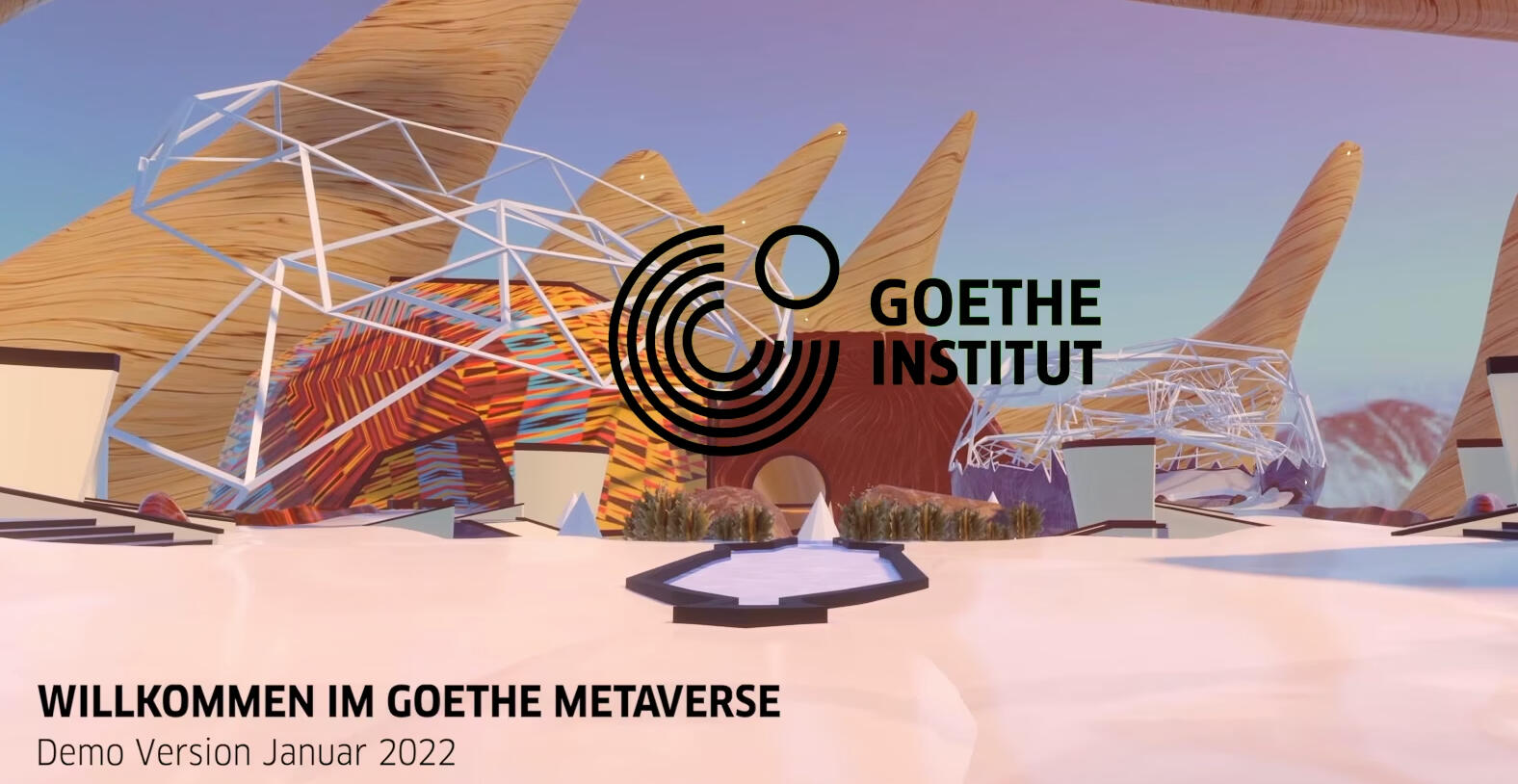
GOETHE VRsum
Target groups & use cases
To develop use cases and understand the target group, we organized 3 virtual workshops with Goethe-Institut staff members in which different target groups (partners, the public, internal target groups) for digital events were examined together and user scenarios for the virtual world were developed.Each workshop had a focus to target the 3 different interests Goethe Metaverse
- Artist & Collaboration
- Education and Language
- Visitor Programme and Events

After Multiple iterations that lasted a few weeks, we decided that each of these interests would get a space dedicated to it. Many important features were identified



Artistic Collaboration Use Case
Daily tool for artists collaboration
Description
Digital art and exhibitions in virtual spaces are still novel for many artists and partners of the Goethe-Institut. To have a collaborative environment to explore the opportunities of new ways of creating and presenting art in the digital age, the GoetheVRsum will be used as a tool for co-production of digital art. Artists can meet 3D designers, curators and other partners in several areas within the GoetheVRsum, which are designed for different purposes and support different kind of working modes. The world can be used for invited users to get inspiration, exchange ideas and to co-create digital art
Features
- Link Integration
- Media Integration (Video Files)
- In world Elements like Open Space, Co production space, safe space, Private Space, Walk and Talk



Education and Language Use Case
Virtual Train Station: Language learning environment for simulating everyday situations
Description
The GoetheVRsum will be used as a complementary offer for digital language courses. It will serve as a learning environment to practice language exercises for everyday situations as well as an online simulation for face-to-face situations. The target groups are language course participants and teachers, which will apply new didactical approaches
Features
- Simple Login with Goethe Password
- Background sound (Stereo)
- Screen Sharing
- Media Integration
- In world elements like Advertizing pillar, suer market, Food automat, Info point, Pharmacy etc.
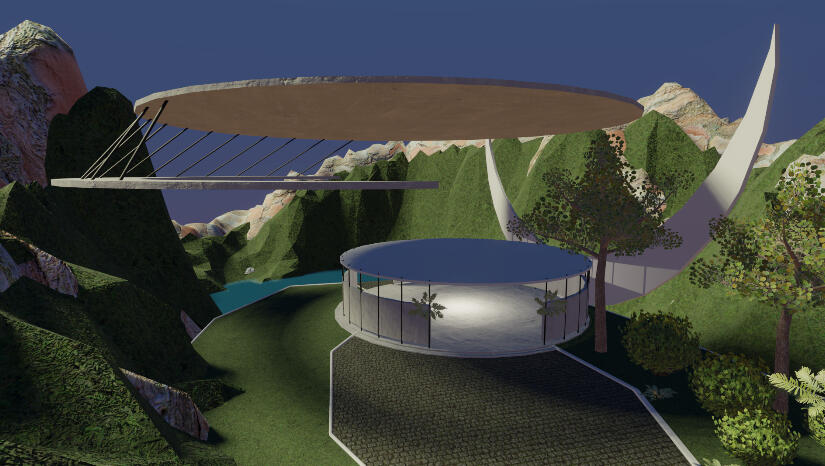


Hybrid Event Use Case
Description
The GoetheVRsum will be used as a complementary offer for physical events. It will serve as digital component for informal networking and to encounter other people. It brings together attendees, speakers, artists, and users worldwide, who might not be able to physically attend. This room can be used for different event formats such as panels, talks or Q&A sessions
Features
- Simple Login with Goethe ID
- Tutorial: How to use the Goethe VRsum
- FAQ: Help buttons
- Minimap
- Default settings for events
- Chat functionality
- Livestream
- Media Integration (Images, GIF's, Videos)
- In world Navigation
- Positional Audio

A concept outlining requirements, user journey, and potential features was presented for feedback.Visual designs for virtual meeting spaces were created based on the Metaverse prototype and tested with stakeholders. After the concept was approved, the virtual environment was built using assets provided by Goethe-Institut. The world was iteratively tested with their employees and refined as needed
Tales Of Us (Client #2)Tales of Us is making it easier for kids from all over the world to play and create together in 3D spaces. World of Us offers a growing multiplayer world where players can build. As we did with the Goethe Institute, we held workshops to teach kids how to make 3D objects and let them add their creations to the game. This helps them learn and share their backgrounds and stories in a safe place.



TRAYCE / METALABELPerformed product Discovery for new ideas of Rob Kalin (Etsy's founder) and Yancey strickler (Kickstarter's founder)
THE CHALLENGE
- Define and explore the viability of Trayce A better Marketplace
- Develop innovative blockchain protocols that could integrate billions of individuals not currently engaged with blockchain technology
- Create a cooperative framework for labels to efficiently produce and circulate their creations.
Creation is an individual endeavor, whereas forming a label is a collective effort. Discover more about Metalabel and it's Inception
MY PROCESS
- Employed an array of product discovery strategies including "Painstorming", "Crazy 8", in-depth user research, prioritizing personas, and charting user/empathy journeys.
- Guided masterful web 2.0 product builders through the intricacies of web 3.0, by utilizing my expertise in blockchain technology
- Established Information Architecture and PRD documentsRESULTS
- My in-depth analysis and exploration led Rob Kalin to understand that launching Trayce as a more equitable marketplace was not a viable move.
- Assisted Yancey Strickler in advancing the concept of METALABELS.
- Influenced Rob and Yancey's decision to reject a 10M investment from CELO based on my insights and understanding of the CELO infrastructure.

TRAYCE THE BETTER MARKETPLACE
We are What we makeOur surnames once mirrored our professions like smith, brewer, weaver, etc. But does our work still define us today? For creators, their works tell their life's story. What legacy do these creations hold?We make what we areThough the industrial age has shifted our work from our identities, the innate drive to derive purpose from our work persists.How might we marry our work with our passions and foster value-driven economies?Building with PurposeBlockchain offers a path to build meaningful economies. We must bridge the gap between its potential and the uninitiated masses.Join Rob (Etsy) and Yancey (Kickstarter) in crafting protocols to make this technology widely accessible.Our VisionWe foresee a world where creators retain and integrate the main value from their creations.We aspire to a world where a company's worth is measured by its service to people, not its profits.

I kickstarted a qualitative user research with 15 makers to identify their problems. Crafted each question very carefully and collected their responses in segmented categories


Conclusions from the User research- Creators would like their selling tools to be fast and easy – quick to upload the products & manage them. Simplicity is key.- Good curation, not being accessible to all the interested sellers seems to be important – both from the perspectives of sellers and buyers.- Some form of connection with the platform, easy contact would be appreciated, however, not everyone would have time to truly engage in co-creating or co-managing the platform. They usually do a lot of things & would like to focus on their work- Creators want their tool to take care of the Sales/Business side of things. For eg. marketing, pricing strategy, business model templatesDefining Flows and funnels
Together with a Product Designer we explored all the user journey, funnels and flows


To clearly capture the ideas and vision in Rob and Yancey's head, we organized Carzy 8 workshop techniques. We were able to gather many insights to proceed further on the first low fidelity designs

Concluding Product Discovery for TrayceAfter spending a couple of months on the research, we concluded that our assumptions were not ENTIRELY CORRECT. Rob Kalin decided to abandon the idea of the marketplace


METALABELMetalabel’s mission is to help people create, join, and support labelsLabels earned a bad rep from years of shady major label accounting and the rhetorical appeal of independence. But labels are much more powerful and value-creating than culture gives them credit. Labels are startups for culture. Labels:- Identify a perspective or mission to reflect in wider culture.
- Acquire and redirect resources (funding, people, social clout) to support ideas and projects in line with that cultural lens or goal.
- Provide seed funding and economic security to artists and others in their scenes.Being a creator is the individual act of creation. Being a label is the collective one. A label is a group of people using a collective identity to enable a specific way of seeing into the world.


From the Enlightenment to Abolitionists to Baohaus to Dada to the Whole Earth Catalogue, throughout history artists, activists, and entrepreneurs have come together to create culture and to advocate for new ways of living and seeing. But there’s never been a simple descriptor or set of tools to define these projects or to help them operate more efficiently, more creatively, more democratically, or at greater scale.Metalabel.xyz defines a new category: the culture label. This category includes record labels, fashion labels, art collectives, movie studios, and publishers, as well as activists, DAOs, and other internet-first groups. We help these labels:- Release, contextualize, and sell their work
- Engage with Web3 tools and business models
- Connect with followers, funders, and collaboratorsWe are CEO/Cofounder Yancey Strickler (Cofounder/ex-CEO Kickstarter), Executive Chairman/Cofounder Rob Kalin (Cofounder/ex-CEO Etsy), Product Lead Hitesh Kar, Design Lead Ilya Yudanov, and Community Advisor Austin Robey.Metalabel is a Web3-native product that operates across chains with foundations in Celo and Ethereum. We will launch with a multi-million dollar grant fund for new and existing labels. Learn more with a deep dive into culture labels and Metalabel.
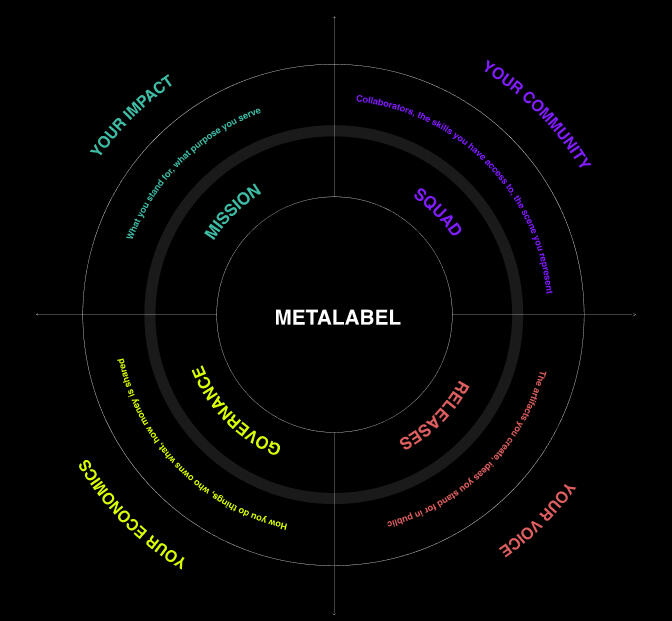


Employing similiar Product Discovery strategies we were able to create low fidelity UI fairly quickly. It was very useful to be able to communicate our ideas to all the people we were talking to





FRESH CARE
Empowering senior family members with design and intelligent electricity meters
THE CHALLENGE
- Take existing hardware and consumption data and ideate a new product based on a general idea of "Making seniors independent and safe"
- Work with Data scientists and UX experts to build an algorithm to Detect wellbeing of seniors with an algorithm and send a daily report to their family membersMY PROCESS
First, I facilitated workshops with the data science team to identify data and hardware limitations. Following that, user journeys (based on our personas) were used to define this innovative product within tight constraintsRESULTS- Our ideation and research identified mornings as the most critical time of day for seniors. The algorithm detects anomalous electricity use in the mornings, which may indicate well-being issues. Unlike competitors, Fresh Care needs no cameras or added hardware, so seniors feel independent and empowered. Family members receive SMS notifications about potential problems
- Piloted to 20 households

Personas and user journeys
To define the product, we used personas and user journey maps. This helped us to pinpoint the morning as the most important time. Personas were based on family members of our pilot customers


User journey 1 — senior is all right
This journey follows our user throughout their day, focusing on their thoughts and action related to their senior relatives

User journey 2 — something happens to the senior
We identified an opportunity to send an SMS notification as soon as any abnormality is detected

Sketch interactive prototype was used for testing. Figma was not yet big in town

Onboarding new users
The dashboard graph and the algorithm are explained to users during onboarding. The algorithm detects all electrical consumption on top of always-on devices and refrigerator. If there is no activity detected (electric consumption doesn't increase in the morning), an SMS alert is sent out

Since everyone wakes up at a different time, the end users (family members) can set the exact time in which they want the algorithm to run — corresponding to their senior's relatives wake up time.


Keeping family members in the loop
The live consumption graph lets users immediately notice anomalies. Daily activity reports provide end-users with a quick overview of the wellbeing of their senior relatives. If necessary, they can explore further on the graph, with the last 30 days of data availableFreshcare flow
The user-defined morning period is visible on the graph.

Users can add their senior relative's phone number to the home screen. This incentivizes communication with seniors, and a quick call can be placed in the case of an emergency.

The morning period message shown on the dashboard is defined for every case.

Emergency alerts
The most important part of Fresh Care is outside the app. SMS alerts are sent at the end of the morning period if there is no activity. They also get sent out if there are errors, whether with the internet, algorithm, or data inconsistency.
Knowing an SMS is sent only in the case of emergencies, users can open the app and take necessary actions.

Fresh Energy
Use smart meter data to build customer-focused products that explain their energy use. Raised €6m since 2017
THE CHALLENGE
- Bring product to Product Market Fit (Atleast 5000 B2C paying users)
- Perform product discovery for different monetization use cases
- Build white label backend to cater to Millions of B2B2C usersMY PROCESS
Worked closely with the Founders, Operations, Data Science, Marketing, Business Development, Product Design, Dev teams to align with everybody's expectations. We invited users for in-house testing to identify user goals and define aligned feature roadmap. A private Facebook group was opened for our users . We conducted weekly surveys on features they would like to see and problems they were experiencing. Conducted many design sprints and deep-dove into company values in multiple sessions with the managementRESULTS- Fresh Energy successfully sold to strategic partners. Investors and founders made money
- Reached 6000 B2C users
- 4 White label enterprise signed contracts with Millions of Households in contracts. Functioning white label product. Making this happen was exceptionally hard as requirements from multiple enterprise customers had to be taken into tech stack's considerations
- CAC was reduced by -20% for B2C
- Pilot Run and experimented with many different use cases
- Many requested features (by public vote) were rolled out

Information Architecture
Reformed the information architecture based on user research interviews. Replaced side menu with tab bar navigation. Added profile, household info sections based on user research interviews. Added services section to support future business goals.

Why did the users sign up?
- To check live and historic electricity consumption
- For real-time total monthly cost plus disaggregated costs of appliances

Up to 2-second resolution for consumption data is available.

Month navigation was moved to the bottom to improve usability.
Specific appliances were identified based on their patterns (Using Data science algorithms) and disaggregated. This means that we could determine how much energy a particular appliance used/cost precisely. Color-coded bars communicate relative consumption between detected appliances.

A live meter readout was implemented as well. This meant that Fresh Energy users can check their meter status without a trip to the basement

Reducing cost to serve
To change their data, users had to call customer support as there was no edit functionality in the app. The weekly average was 6 support calls per 1000 users. With the help of developers, we added all the information we had on our users to the profile section and made most of them editable
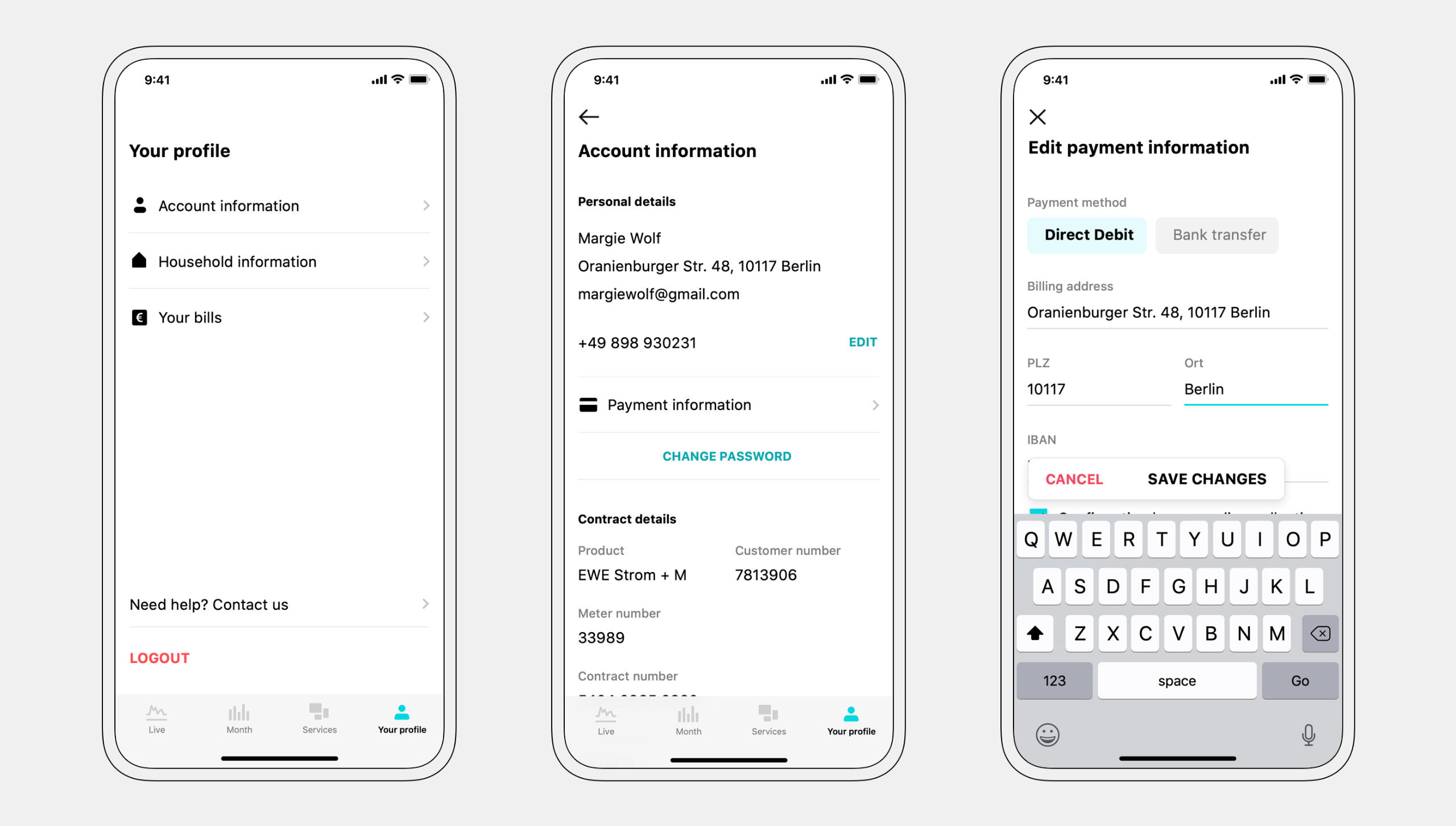
Meeting business and user goals
Using the data from User research, and working with the Operations, Bussiness development. Marketing, Customer Support teams, we were able to ideate new, innovative services. By using only existing data, we saved precious development time and reduced time to market.

Designing new services
Before building a new service, we assessed its viability with a simple pilot project. Pilot projects were done through email communication and manual work. For eg. with a dummy button in the app. (Checked how many people click the button) After confirming the demand, we went ahead with the actual implementation in the product. The design was tested during and after both UX & UI phases.
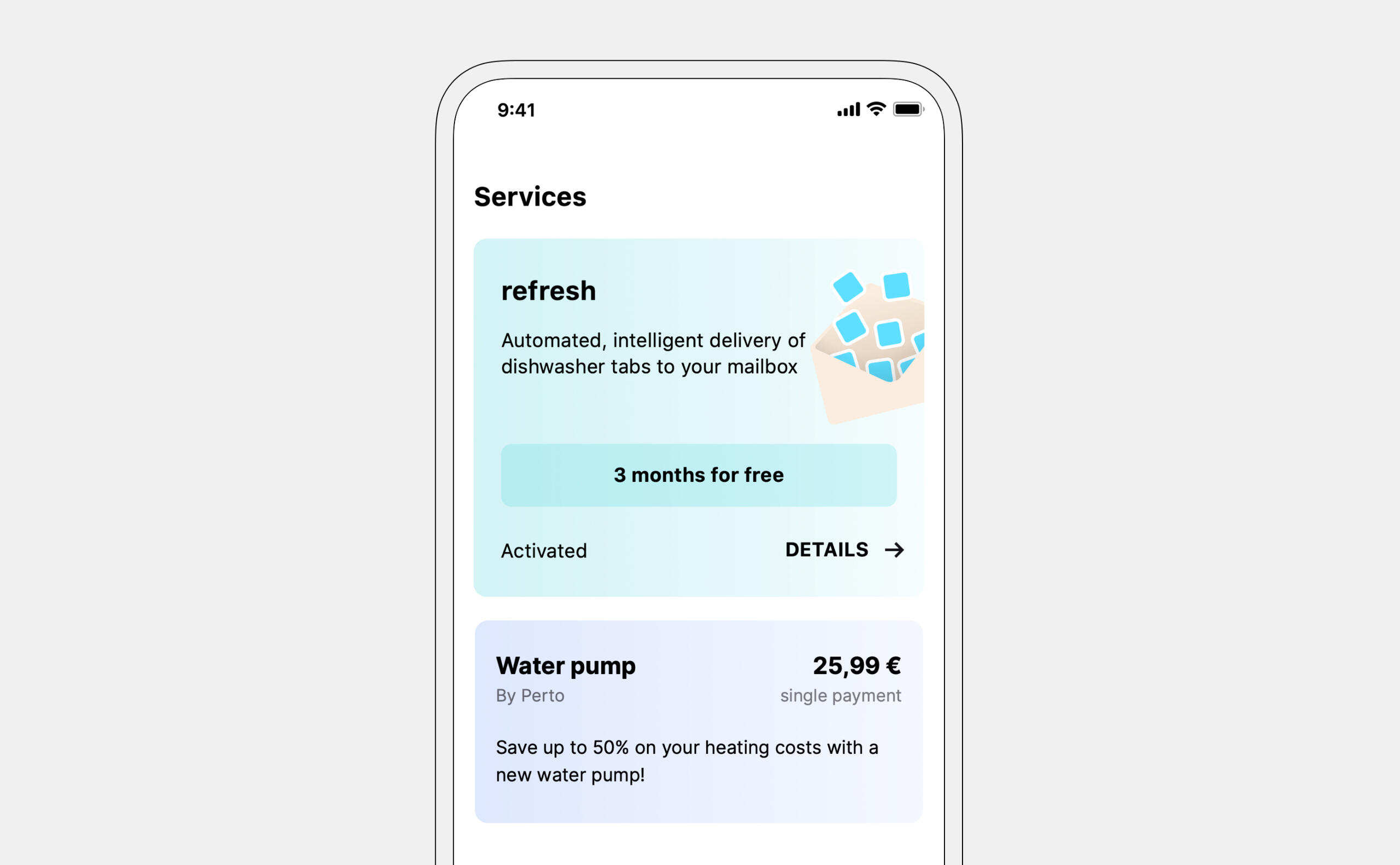
Service 1 -- REFRESH
“Refresh” is a subscription service, based on existing data. An algorithm detects how many times our users use their dishwasher. A package of dishwasher tabs is automatically sent out so it arrives exactly when they run out — giving our users a magical experience

Service 2 -- FRIDGE RECOMMENDATION
Through research and pilot projects, we found out that most of our users had no idea if their fridge spending was below or above the average for a given fridge size. The app analyzes our users' fridge consumption and compares it to our database. Based on the comparison, we calculate potential monthly savings — together with the amortization time for a new fridge.

I facilitated a short 3-day product discovery to define and quickly prototype this feature. We found out that our users primarily wanted to upgrade to a bigger fridge. This impacted the final design. Fridges that cost more were added to the comparison as well.Consistent experience
We provided a desktop version as well. It was designed with the same basic functionality, but expanded with more information due to more screen real-estate

A graphical way of displaying electric consumption was added to the desktop version.

For bills, a quick overview of the most important information is shown on the same screen.
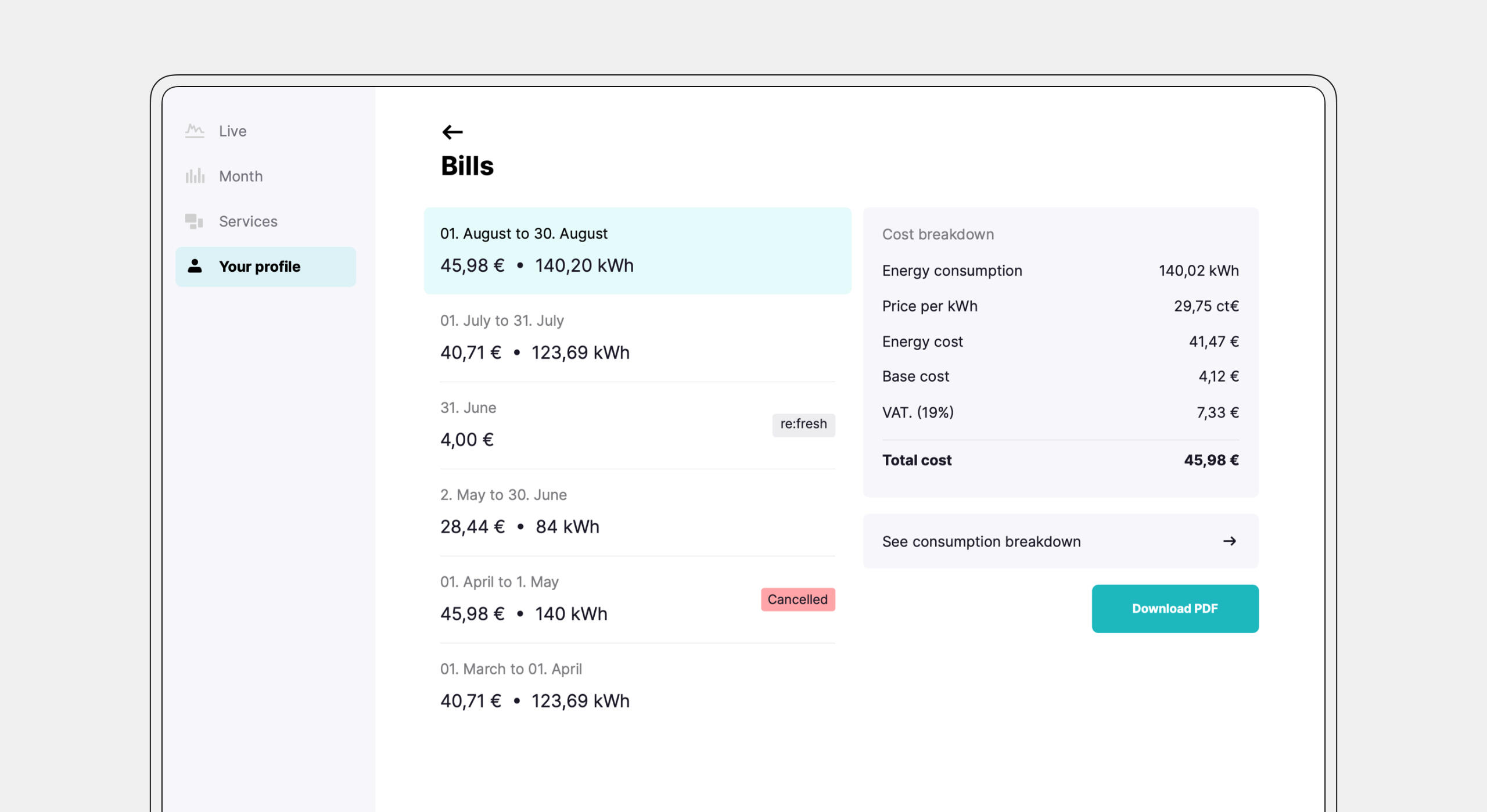
Supporting our B2B Enterprise partners
Our CAC was still too high and a part of strategy to grow was to contract bigger enterprise and provide them with white-labeling product. For this we needed the following
1. Databahn -- A backend system that keeps enterprise data separate in different sandboxes
2. Consistent API architecture that serves multiple clients (Front end apps) for each enterprise. This was particularly hard as I had to negotiate with multiple partners to standardize our features. Each partner wanted different features, but we had only 1 Backend system to serve them all






3. Admin dashboard for our partner's customer support. All users and smart meters are visible on the dashboard. Admins can quickly CRUD create, update, delete, and connect meters to users to serve their own customers

Issues with either users or meters are communicated clearly so the support department can act quickly.

The dashboard was a great selling point since most of our B2B customers didn't have a similar solution for their own userbase.

GREEN BUSSINESS DEVELOPMENT
European New Mobility Expert Survey 2016 / ENMS'16
8 European Countries - 200+ Experts - 9 Business Sectors
CHALLENGE
The mobility sector is transitioning from product-centric to service-centric models, with an influx of startups introducing diverse new mobility services. This rapid evolution has led to a lack of transparency in the market. To address this, Green Business Development (GBD) GmbH undertook an expert survey to clarify the landscape of 'new mobility', encompassing carsharing, ridesharing, e-hailing, intermodal services, parking, and logistics
PROCESS
- Analyzed survey data from 200 automobile experts
- Worked with UI designer to create useful graphicsRESULTS
- Created a good lead magnet for Green Business Development via this report


SYNOPSYS
Waterfall product management, fully managing development from writing specs to building demos
CHALLENGE- Drive product features based on customer needs (Hisilicon, Apple, Samsung, Infineon etc. )
- Work with international developer and tester teams across 3 continentsPROCESS- Trained in full ASIC flow
- Optimized TIO and CTS in IC Compiler
- Wrote product specs and test plans
- Conducted beta testing, characterization, documentation review
- Created demos
- Developed and delivered training materials
- Guided customers through tapeout flows
RESULTS- New TIO technology was accepted in 21 customer flows within a year


CENTRE FOR ARTIFICIAL DEFENSE RESEARCH
CHALLENGE
- Design MATLAB technique to estimate LIDAR sensor orientations
- Develop real-time road detection system for autonomous vehicles. Do all of this, years before Machine learning algorithms were really invented
PROCESS
- Wrote a code to caliberate pitch yaw and roll based on the mount of the LIDAR
- Applied contour extractions to image data to extract road boundariesRESULTS
- LIDARs could be automatically calibrated


ASIMOV VC
Deep dives into the automotive, energy, and trucking, identifying investment prospects. Vetted and referred top founders for partnership evaluation
CHALLENGE
The European startup landscape is thriving, particularly in the Automotive, Trucking, and Energy sectors. Our Limited Partners, with substantial investments in fossil fuels, are seeking to branch out into cutting-edge deep tech opportunities
PROCESS
- Performed deep market research
- Prepared research for my partner to make investment decisions
RESULTS
- In 2017, everybody was chasing the ride hailing market that was only ±$100B. However, we went after trucking $800B in US alone and $400B in Europe. Successfully 20X with Sennder
- Engaging daily with visionary founders has been profoundly influential, igniting my passion and guiding me along the path of entrepreneurship
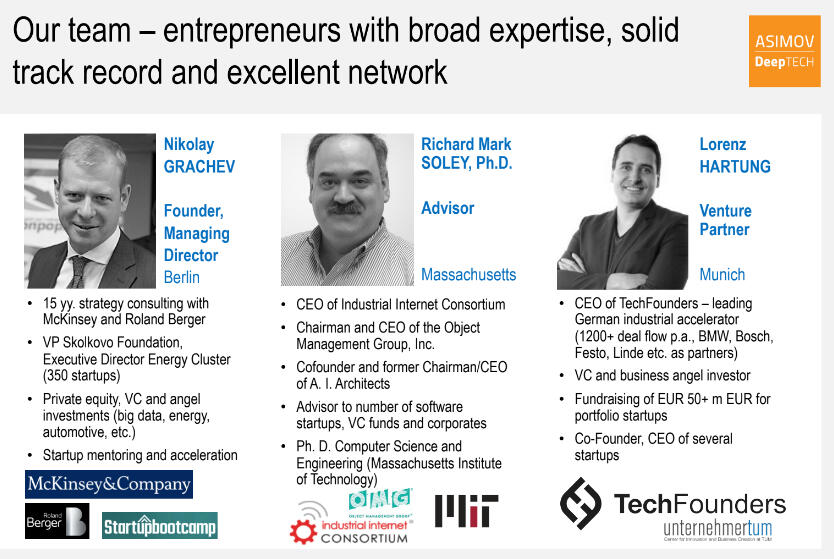
My tenure at Asimov VC was an extraordinary journey that granted me the privilege of engaging with some of the most brilliant minds in the industry. Below, I present a selection of the research initiatives I undertook

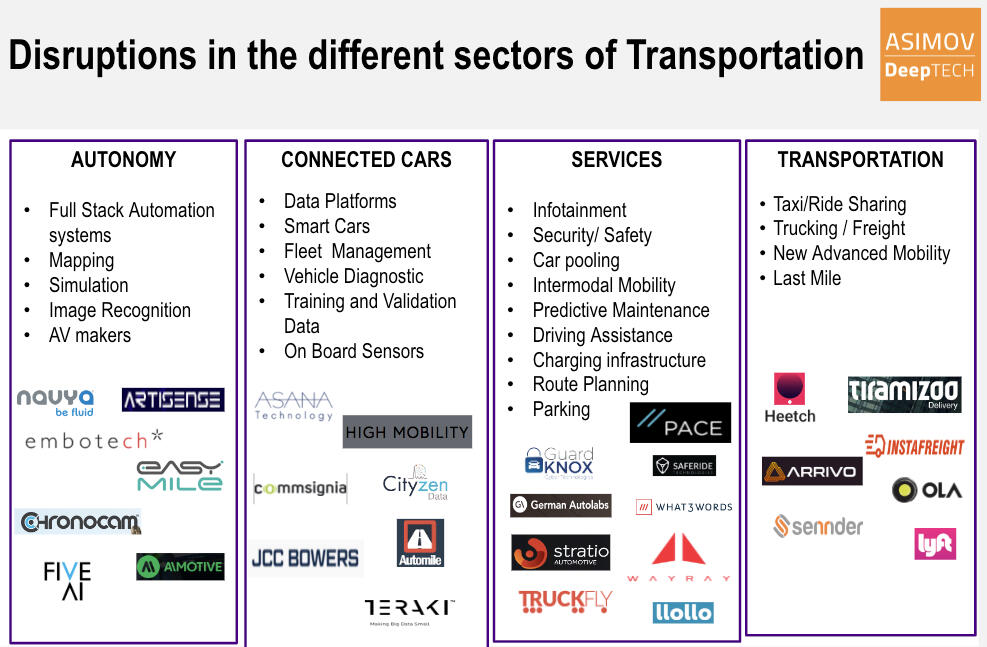


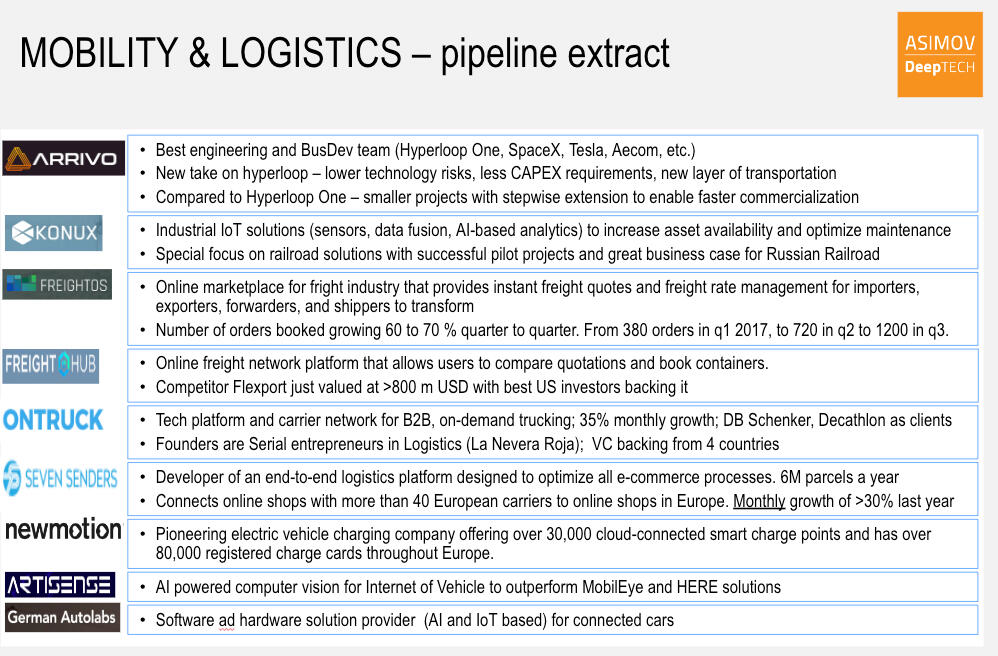

I spoke to multiple startups every day and gathered insights. To ensure privacy of these startups I am not sharing their pitch decks here















